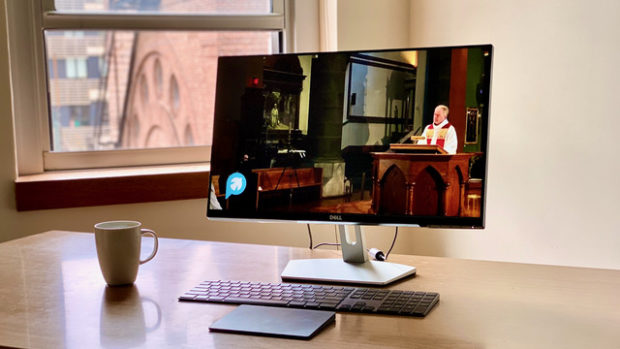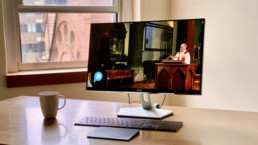You can Zoom a Mass, but Confirmation will have to wait
A version of this story was published in Religion News Service
You can Zoom a Mass, but Confirmation will have to wait
Ricardo da Silva, S.J. | rd2920@columbia.edu

Since the beginning of February, a small group of Roman Catholic young adults has been meeting at the Church of St. Paul the Apostle in Manhattan, to prepare for the rite of Confirmation which they were to receive this Easter.
For the past three years, Emily da Silva-Prado, 25, had not managed to organize herself to attend Confirmation classes. When she enrolled this January, she was determined that by Easter 2020 she would be Confirmed.
But only a few weeks into da Silva-Prado’s instruction, the coronavirus would strike New York, shutting down all non-essential services in the city. Among these, religious institutions like St. Paul’s.
“To be honest with you, I just didn’t take it seriously for quite a while,” da Silva-Prado said, remembering her initial reaction to the public health crisis that has, now, crippled New York and much of the world.
But the unreality of the situation would quickly change for her.
“It got really real for me when we canceled class.”
Suddenly, the Sacrament da Silva-Prado had put off for three years, now deeply desired and had finally been preparing to receive, was left in the balance.
The Catechism of the Catholic Church teaches that during the celebration of the Sacrament of Confirmation, believers are “enriched with a special strength of the Holy Spirit” and become “true witnesses of Christ,” completing the grace they received during the Sacrament of Baptism, which most receive as a child.
Confirmation has its roots in both the Christian and Jewish traditions.
In the second chapter of the Acts of the Apostles in the Christian Bible, the disciples are gathered in Jerusalem during Pentecost, a word that stems from the Greek for “fifty.”
The scripture recounts how 50 days after the resurrection of Jesus from the dead and 50 days after the Jewish celebration of Passover — “a noise like a strong driving wind” entered the room where they were gathered and with it, “tongues as of fire which parted and came to rest on each one of them.” When this happened, the disciples “were all filled with the Holy Spirit and began to speak in different tongues, as the Spirit enabled them to proclaim.”
It is from this collective experience that the Christian community is said to have been born. In that instant — even though they spoke different languages — their common experience united them in understanding. That experience, Catholics say, is much like the status of their church today, a church that is spread across the world yet follows the same liturgical ritual and offers the same Sacraments to believers everywhere.
A first-generation American Brazilian, da Silva-Prado was raised Catholic. But as a teenager, when the time came for her to be confirmed, she had other things on her mind.
“This is full disclosure,” she said, looking down, her cheeks growing redder and redder. “It was more for a boy.”
She left the Catholic Church so that she could spend more time with her high school sweetheart.
As a young high schooler at the time, she reckoned she could fulfill both her desire to go to church and to be with her boyfriend, by going to his Brazilian Baptist church instead. Not long after, she encouraged her mother to join her — leaving her father to attend Catholic Mass on his own.
But two years ago, following a “conversion” trip to Italy, da Silva-Prado, who is an art historian and educator of ancient religious works at The Frick Collection, decided it was time to return to the church of her childhood.
“I don’t know,” she said, “When I was at the different churches; when I was in Rome; when I went to the Vatican — something happened where it just all made sense.” It was then that da Silva-Prado decided to begin Confirmation classes. But, short of two months in, with the coronavirus taking hold in New York, her class was quickly forced to find a new way to meet.
After the citywide shutdown, the priest teaching the class, the Rev. Paul Rospond, was determined to continue the program he began teaching at the parish center. “I can actually see the people’s faces on Zoom,” he said, laughing at a discovery that now seemed silly to him. “It took me a week to figure it out!”
Before the coronavirus hit — a time now jokingly referred to as time B.C. — the priest, who is 68 years old, had never taught a class on Zoom, the online video conferencing platform that allows people from all over to meet in a virtual room. “It’s a little more difficult,” he said. “You don’t get the same kind of rapport or feedback.” But, “I’m grateful that I have a way to continue, that gives me some hope that we’re finding ways to continue our ministry. That’s very important. Now, when people will get confirmed, who knows.”
“It’s a time where we really have no precedent,” said da Silva-Prado as she tried to make sense of the shape her faith would take in forced isolation from her community. “It’s been odd doing it through Zoom. It’s not like in-person where you can kind of be, ‘Oh wait, I didn’t quite get that’ or ‘Could you repeat that?’ or ‘Can we go a little bit further in-depth?’.
The new and somewhat stilted format of the class is proving especially difficult because this time has forced da Silva-Prado to think deeply and differently about her life, without the reassuring security net of personal face-to-face contact with a priest or her friends. “I think that this is a time where we’re being asked to take stock of our lives and really evaluate what’s important; what is not,” she said.
“What is that life in the church when we don’t have the physical building anymore?’”
She took a second to digest her question.
“I’ve never lived in a time where Church has been canceled — ever,” she added. “That’s just so scary and very frightening. You don’t know when it’s gonna come back.”
“We are participating through watching Mass online; watching Mass on television,” da Silva-Prado said. “But the physical Mass, I thought that I could attend forever and ever and ever — till kingdom come — is canceled.”
This time of forced introspection and self-quarantining is testing, but da Silva-Prado is confident “there will be an end to this,” she said. “It will be like the raising of Lazarus, that will be amazing and wonderful and miraculous.”
Still, she doesn’t want to avoid the pain nor lose sight of the seriousness this moment has called her to recognize. “There needs to be this death first,” she said, recalling the present unabating cycle of death taking place in New York. “There needs to be the weeping. And Jesus will weep with us and he’s there in our suffering as well. And I’m positive and I’m confident in that. I just think that it’s going to be longer than we expect.”
The prolonged wait to return to her church is only exacerbated by the indefinite wait to be Confirmed.
The Confirmation ceremony is usually presided over by the local bishop and involves an elaborate set of rituals. It is not something that can be done on Zoom.
In the traditional Confirmation ceremony, the bishop smears oil on the foreheads of those being confirmed and lays his hands on their heads. The ritual is meant as a sign that strengthens the faithful to persevere in the Catholic life and to serve as full-fledged members of the church. A strength upon which many now rely.
“The touch is important,” said Rospond. “The anointing with the oil is important; gathering together for the sacrament is important; the connection with a bishop is also important.”
For da Silva-Prado, her classmates and many who were expecting to be received formally into the Catholic Church this Easter — which last year in the United States were more than 37,000 people — they will have to wait indefinitely for a time when they can, again, gather inside churches. No date has been set for this year’s Confirmation.
But when it does come, da Silva-Prado said she will be ready. “I think that Confirmation is going to mean a lot more when this is all over.”

